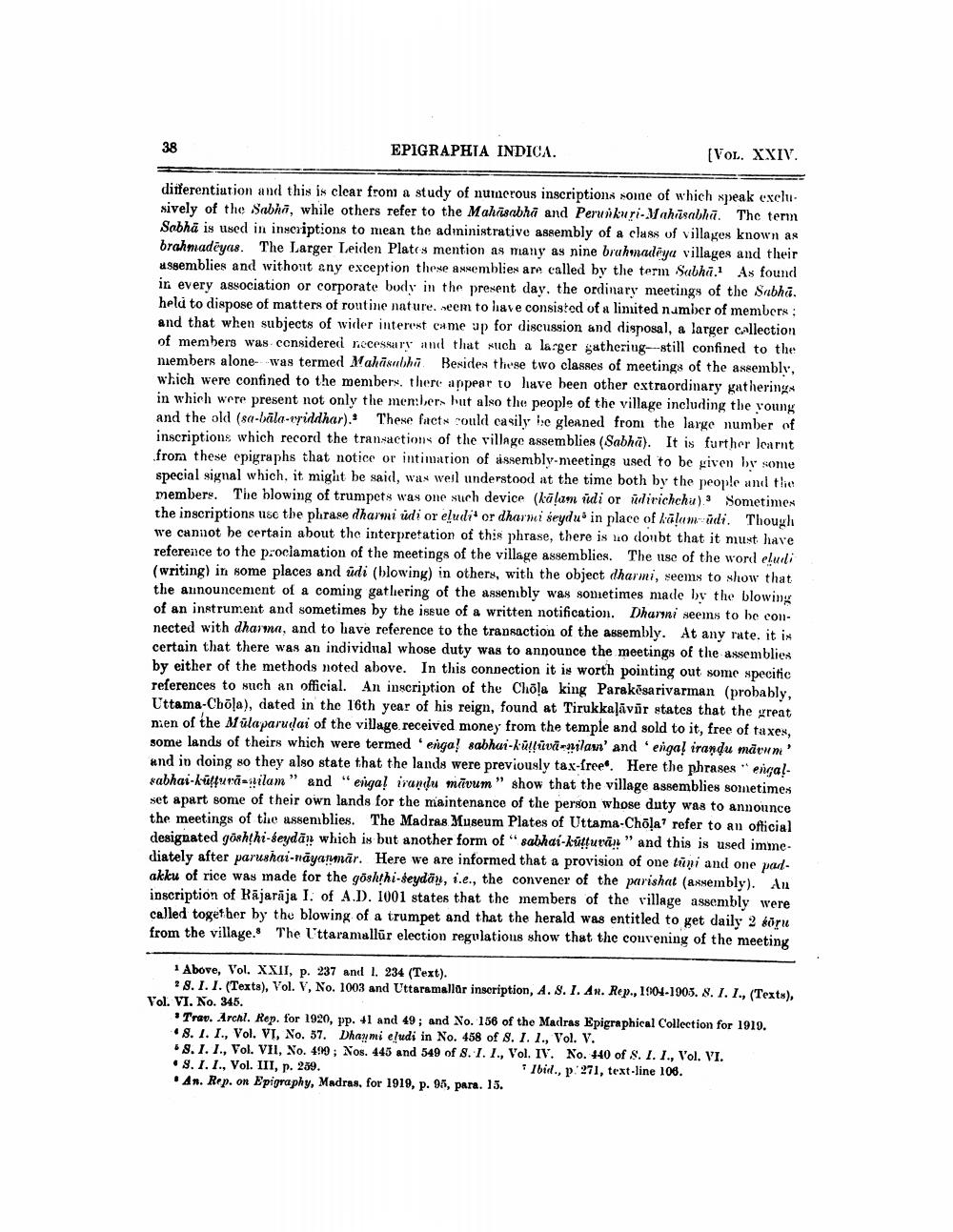________________
38
EPIGRAPHIA INDICA.
[VOL. XXIV.
differentiation and this is clear from a study of numerous inscriptions some of which speak exclu sively of the Sabha, while others refer to the Mahasabha and Perunkuri-Mahasabha. The term Sabha is used in inscriptions to mean the administrative assembly of a class of villages known as brahmadeyas. The Larger Leiden Plates mention as many as nine brahmadiya villages and their assemblies and without any exception these assemblies are called by the term Sabha. As found in every association or corporate body in the present day, the ordinary meetings of the Sabha. held to dispose of matters of routine nature. seem to have consisted of a limited number of members; and that when subjects of wider interest came up for discussion and disposal, a larger callection of members was considered necessary and that such a larger gathering-still confined to the members alone was termed Mahasabha Besides these two classes of meetings of the assembly, which were confined to the members, there appear to have been other extraordinary gatherings in which were present not only the members but also the people of the village including the young and the old (sa-bala-vriddhar). These facts could casily be gleaned from the large number of inscriptions which record the transactions of the village assemblies (Sabha). It is further learnt from these epigraphs that notice or intimation of assembly-meetings used to be given by some special signal which, it might be said, was weil understood at the time both by the people and the members. The blowing of trumpets was one such device (kālam udi or divichchu) Sometimes the inscriptions use the phrase dharmi udi or eludi or dharmi seydus in place of kalam udi. Though we cannot be certain about the interpretation of this phrase, there is no doubt that it must have reference to the proclamation of the meetings of the village assemblies. The use of the word eludi (writing) in some places and udi (blowing) in others, with the object dharmi, seems to show that the announcement of a coming gathering of the assembly was sometimes made by the blowing of an instrument and sometimes by the issue of a written notification. Dharni seems to be connected with dharma, and to have reference to the transaction of the assembly. At any rate. it is certain that there was an individual whose duty was to announce the meetings of the assemblies by either of the methods noted above. In this connection it is worth pointing out some specific references to such an official. An inscription of the Chōla king Parakesarivarman (probably, Uttama-Chōla), dated in the 16th year of his reign, found at Tirukkalavar states that the great nien of the Mulaparudai of the village received money from the temple and sold to it, free of taxes, some lands of theirs which were termed enga! sabhai-küllüvā-nilam' and 'engal irandu māvum' and in doing so they also state that the lands were previously tax-free. Here the phrasesengalsabhai-kultura-silam" and "engal irandu mavum" show that the village assemblies sometimes set apart some of their own lands for the maintenance of the person whose duty was to announce the meetings of the assemblies. The Madras Museum Plates of Uttama-Chōla' refer to an official designated goshthi-seydän which is but another form of "sabhai-kuttuvan" and this is used immediately after parushai-nāyanmar. Here we are informed that a provision of one tuni and one padakku of rice was made for the goshthi-seydän, i.e., the convener of the parishat (assembly). An inscription of Rajaraja I. of A.D. 1001 states that the members of the village assembly were called together by the blowing of a trumpet and that the herald was entitled to get daily 2 soru from the village. The Uttaramallur election regulatious show that the convening of the meeting
1 Above, Vol. XXII, p. 237 and 1. 234 (Text).
28. 1. 1. (Texts), Vol. V, No. 1003 and Uttaramallar inscription, A. S. I. An. Rep., 1904-1905. 8. I. I., (Texts),
Vol. VI. No. 345.
Trav. Archl. Rep. for 1920, pp. 41 and 49; and No. 156 of the Madras Epigraphical Collection for 1919.
8. 1. I., Vol. VI, No. 57. Dhanmi eludi in No. 458 of 8. I. 1., Vol. V.
8. I. I., Vol. VII, No. 499; Nos. 445 and 549 of 8. I. I., Vol. IV. No. 440 of S. I. I., Vol. VI.
8. I. I., Vol. III, p. 259.
T Ibid., p. 271, text-line 106.
An. Rep. on Epigraphy, Madras, for 1919, p. 95, para. 15.




